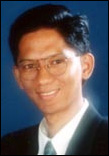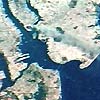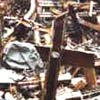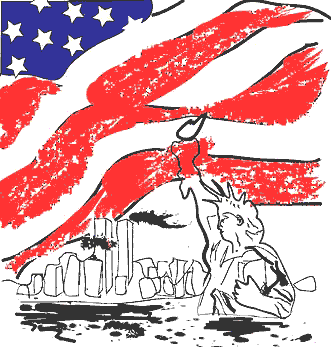Until that dreaded day a year ago, partygirl may have just been one of the many little-known online diarists on the Internet. Pre-Sept 11, she spoke of movie stars, ghosts in her bedroom and imaginary boyfriends -- just another 28-year-old living in "post-college insanity" in New York City.
After the attacks, partygirl joined thousands online documenting their anguished searches for loved ones. Many discarded previous navel-gazing for grassroots journalism: posting pictures, audio, video, first-person accounts and anger-fuelled reactions.
Forums, discussion boards, newsgroups and chatrooms lit up with posts. Mainstream sites were found wanting or inaccessible from the huge spike in visitors on the day.
Usage surveys suggest how millions turned onto the Internet to grieve, console, reconnect with old friends, share news and views, debate and argue the country's response.
Immediately after the attacks, keepers of online journals, or weblogs, came into their own. Veterans such as Dave Winer of techie weblog Scripting News and web-designer Jason Kottke of kottke.org served up some of the best links popping up on the Internet such as eyewitness videos, latest photographs from various rooftops and webcam shots from the Empire State Building. New York blogger William Shunn started an "I'm Okay" survivor registry to calm the anxious.
New bloggers came on board creating what was dubbed as "war blogging" for weblogs related to the aftermath of 9/11. Both sides of the war/anti-war divide were lobbing posts at each other like so many live grenades. Some proved intelligent; others were just pure drivel.
WEB AS GLOBAL SOUNDING BOARD
Today, a year later, there remains an overwhelming amount of documentation on the attacks on the Internet - not just by bloggers - but by numerous online publishers, historians, archivists, researchers, activists, conspiracy theorists, pundits and web users from around the world.
A simple Google search suggests the Web serves as a great bulletin board for human expression about 9/11.
Click to view seven-year-old's Hernan Hernandez's drawing of a giant man tumbling from the Twin Towers, David Cheung's "Premonitions" painting among the many submitted at WhyProject.org, or read ten-year-old Chen Rou Xin's plaintive haiku: "I'm scared to die / because I am too little to be dead" , or the 35,669 related poems at Poetry.com.
View the somber pages of cartoons of that day at Daryl Cagle's Professional Cartoonists Index , or the 300 quilt panels for a memorial quilt, or the thousands of virtual candles lit at this Danish site.
Flip through grainy photos of 236 missing people on Newsday.com - their smiles frozen on the Internet forever.
The power of the individual shone through in the guise of a Canadian education editor named Anthony Williams. He began a September 11 News archive from his home in Calgary, Alberta, and has gathered an astonishing array of news-clippings, front page covers, magazine covers, photos, videos and art, and is still updating the site today.
In an effort to preserve the explosion of information online, the US Library of Congress also began screen-capturing various sites in collaboration with the non-profit organization Internet Archive, WebArchivist.org and Pew Project researchers. The site September11.archive.org was launched a month after 9/11 for just such digital material.
Officials at the launch spoke of documenting views, not just those of traditional media, but of "online diarists, self-styled experts and the world's forum contributors" as primary source material for future researchers.
"There's been a huge surge in people feeling compelled to make statements about the events online. We see it everywhere online, and we want to preserve a record of it," said one official.
CONSPIRACY THEORISTS AND OSAMA JOKES
Forwarding rumours and conspiracy theories also became an obsession for the web community. The Nostradamus quatrain foretelling 9/11 turned out to be a hoax as was that infamous "last photo of a tourist" atop one of the Twin Towers with the hijacked plane in the background. Some controversial theories still persist: the US Government supposedly had foreknowledge of the terrorists' plan, that the Pentagon plane crash was faked, and that the hijacked plane that crashed in Pennsylvania was "taken out" by the US Air Force.
One repeatedly forwarded email story of a Hasidic Jewish man pulling a Pakistani Muslim man to safety near ground zero with the words: "Brother, if you don't mind, there is a cloud of glass coming at us, grab my hand, let's get the hell out of here," turned out to be true. (View CNN's story on the incident.)
Amid the tragic loss of life, some found their creative streak in humour. Songs and doctored photographs parodying Osama bin Laden and the Taliban popped up everywhere along with revised architectural designs for a new Twin Towers, jokes on Bush's War On Terrorism, and standup one-liners on FBI/CIA bungles (eg:"They say Osama bin Laden is still alive and planning more attacks. Now, the question I have is: Do you want to tell the FBI or should I?").
Since Sept 11, 2001, we seem to have fed the pipes of the Internet with every conceivable side of the human condition, if only, perhaps to vent the emotions from our own systems. The Internet served as a refuge, a sounding board, and a firing range.
A year on, the world has since moved on. It may be true that the memories of men are too frail a thread to hang history from. Now, we have the Web. And the Web doesn't easily forget.
Follow In.Tech now as we revisit some of the more memorable 9/11 sites.
Jump to Left Column of Links
Published in In.Tech, The Star, Sept 10, 2002.






